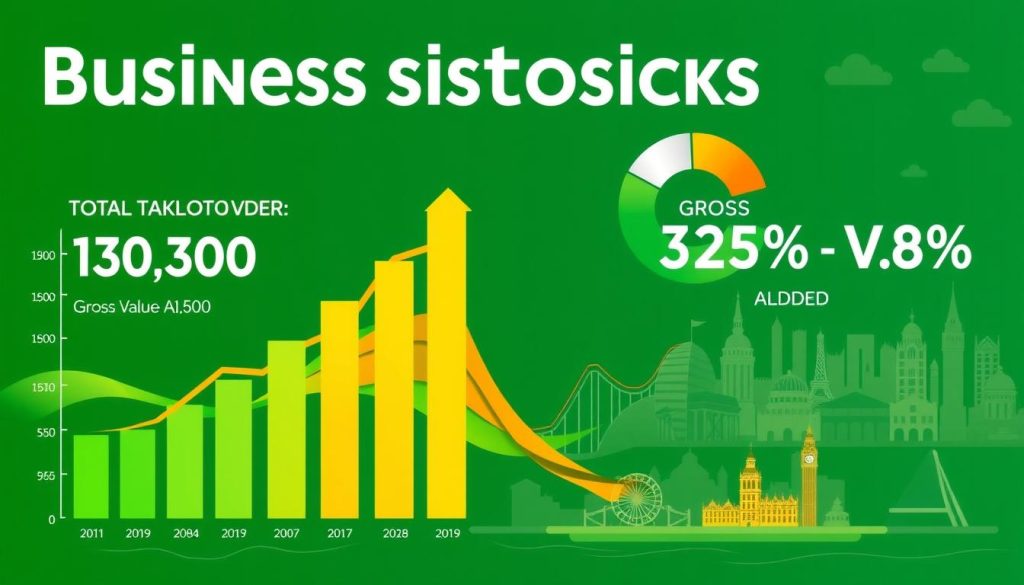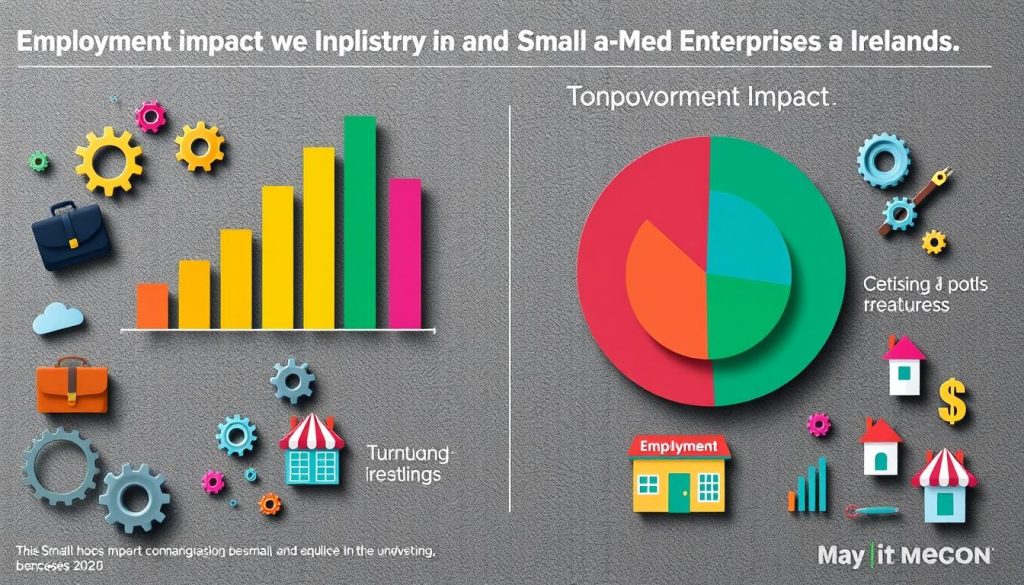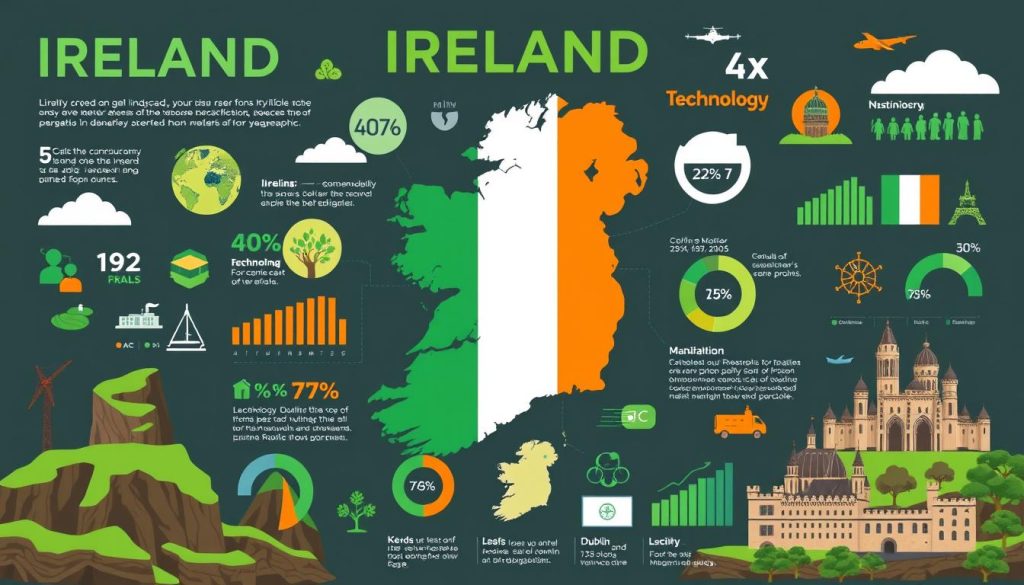In this look at Structural Business Statistics in Ireland, we explore key insights. The Central Statistics Office (CSO) is key, providing detailed data on business activities. The 2022 data shows important trends, especially in employment and business performance.
With almost 2.3 million people working in 2022 and a turnover of €1.29 trillion, these figures are crucial. They show how economic analysis helps in making policies and decisions. Small and medium enterprises (SMEs), making up 99.8% of all businesses, are vital for Ireland’s growth and stability.
We aim to give a detailed look at these statistics. This is to help those interested in understanding the business world better. It highlights the importance of different business sectors in Ireland.
Overview of Structural Business Statistics in Ireland
Understanding Ireland’s business performance is key. Structural business statistics play a big role in this. They help us see how businesses are doing and their impact on our economy.
Defining Structural Business Statistics
Structural business statistics give us detailed insights into businesses in Ireland. They cover things like size, sector, and where they are located. This helps us understand the business world better. The Central Statistics Office (CSO) is crucial in collecting this data through surveys like the Census of Industrial Production and the Annual Services Inquiry.
Importance of Structural Statistics for Economic Analysis
Structural statistics are vital for the economy. They help us track trends and the health of the economy. This information is key for making policies and plans.
By looking at these statistics, we can see what drives economic growth. This helps everyone make better decisions with accurate data.
Key Findings from 2022 Business Statistics
In 2022, Ireland’s economy showed some key numbers. The Total Turnover was €1,288.7 billion, and the Gross Value Added (GVA) was €424.2 billion. These figures help us see how different sectors play a part in the economy.
Total Turnover and Gross Value Added
The Total Turnover across sectors shows Ireland’s economy is lively. The Services sector led, making up 46.5% of the turnover at €598.9 billion. It also had 47% of GVA, at €200.3 billion. The industrial sector was close behind, with about 33.4% of the total turnover.
These numbers tell us about the value each sector brings to the economy. They help us understand the economic landscape better.
Sector Contributions to Turnover and GVA
Looking at sector contributions, we see a balanced economy. The sectors of Distribution and Construction make up the rest. This shows Ireland’s economy is diverse and strong.
The data shows how crucial each sector is. It helps shape policies for growth and sustainability in the future.

Structural Business Statistics in Ireland by Sector
Looking at structural business statistics in Ireland shows us how different sectors help the economy. We see how the Industry, Services, Distribution, and Construction sectors work together. This helps us understand their roles in the Irish economy.
Analysis of the Industry Sector
The Industry sector has 5.5% of all businesses and is key to the economy. It makes over 42% of the total GVA. Manufacturing is especially important, with a GVA of €175.9 billion.
This shows how crucial the Industry is for economic growth and stability.
Insights into Services and Distribution Sectors
The Services sector is the biggest employer, with 61% of the workforce. Information & Communication leads in turnover. The Distribution sector is also vital, adding a lot of value to the economy.
Distributive trades make up 18.1% of EU’s non-financial business economy.
Performance of the Construction Sector
The Construction sector has the most businesses, with 77,676. But it only makes less than 4% of total turnover and 3% of GVA. This shows the sector needs to grow and improve.
Role of Small and Medium Enterprises (SMEs)
Small and Medium Enterprises (SMEs) are key to Ireland’s economy. In 2022, they made up 99.8% of all businesses in the country. They play a big role in creating jobs and boosting the economy.
Impact of SMEs on Employment and Turnover
SMEs help create jobs for about 68% of Ireland’s workforce. This shows how important they are in fighting unemployment and helping local areas. They also make up over 43% of the country’s total turnover, showing their economic strength.
Comparison of SMEs and Large Enterprises
There’s a big difference between SMEs and large businesses when it comes to turnover. Large businesses, making up just 0.2% of all businesses, have 57% of the turnover. This highlights how SMEs are vital for local economies and make the economy stronger.

Future Trends and Projections for Irish Business Economy
The Irish Business Economy is set for big changes. New tech and changes in what people want will shape the future. With more people working, around 2.7 million now, we need to grow in a way that lasts.
Investing more will help our economy grow. This could make our output grow by 0.9% each year. It’s crucial for keeping our businesses, especially SMEs, competitive.
Dealing with an aging population is a big challenge. We need to plan for pensions and healthcare. SMEs must find new markets and go digital to stay ahead.
Growth in 2024 might be around 0.6%. Then, it could slowly go up. Consumer spending and building homes will drive this growth. It’s a chance for businesses to be creative and grow.
In short, the Irish Business Economy has big challenges ahead. But with the right steps, both big companies and SMEs can do well in this changing world.
Summary and Implications for Stakeholders
The structural business statistics from Ireland for 2022 show us a lot about our economy. They highlight the importance of small and medium enterprises (SMEs) in driving our economy. They also show how different sectors add to our overall turnover and gross value added.
This information is very important for policymakers and business leaders. It helps us create policies that support different sectors, making our economy more competitive. It also helps businesses make smart decisions that help them grow and contribute to our economy’s success.
It’s crucial for stakeholders to keep up with these statistics. By doing so, we can spot new trends and plan better for our economy. This will help our economy stay strong and adaptable, even as things change.

